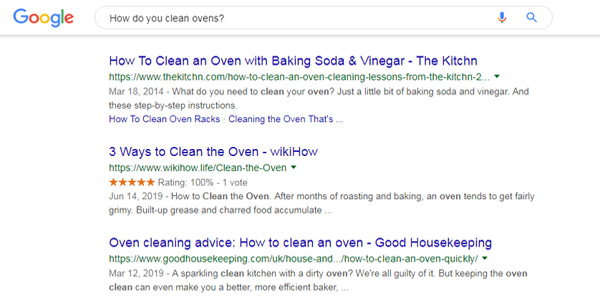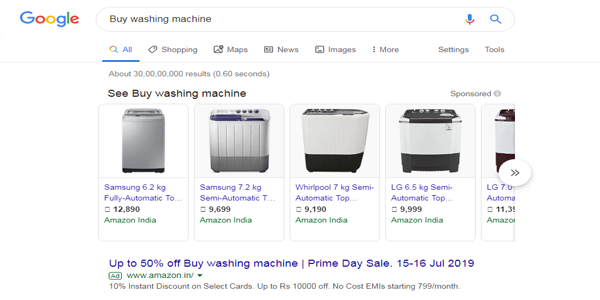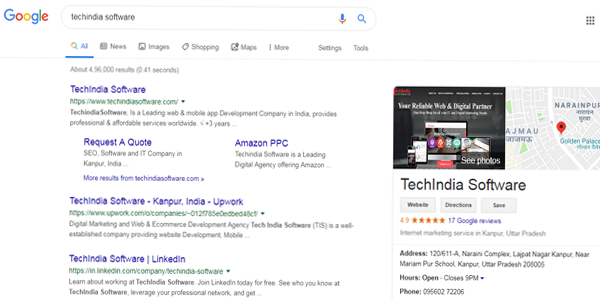Consumer behaviour has undergone a radical change, especially since the time consumers started searching for a product or a service on Google.
Looking at this pattern, Google coined the term “Zero Moment of Truth” in 2011 to earmark this point in the consumer’s journey, when a person has become aware of a product or a service from any source, and is carrying out more research on it, in order to arrive at a considered decision.
Now in 2019, when consumers turn to Google for every topic on which they seek information, it makes sense to have that content in your website which provides answers to their search queries. In other words, when they search for a particular product or service, then your brand or website should appear in the top results.
This is where “Search Intent” comes in.
What is Search Intent and how does it work for SEO?
Search intent can be classified into 3 main types:
– Informational search
This search is more generic. Users do this type of search to either learn about a product or a service, or to get more information that validates their knowledge.

– Transactional search
This search is done by users when they have made up their mind to make a purchase. At this point they do searches to find the best price, check on available deals, compare prices between different brands, and look for the nearest dealer or store location.

– Navigational search
This type of a search is very specific and directed mostly towards a specific company name, brand name, website address or an individual. Users know exactly what they are searching for.

How does Search Intent relate to Google?
To optimize the above-mentioned searches, Google recommends use of those keywords in a website that bring up relevant results and direct users to the desired website. They are known as:
“Know” – informational searches
“Do” – transactional searches
“Go” – navigational searches
In other words, by keeping “know,” “do” and “go” within your research, one can easily identify relevant keywords and bucket them by intent.
Is there a tool available to identify and bucket keywords?
Yes, there is a tool available now. While earlier on bucketing of keywords was done manually, Keyword Keg is an ideal tool that optimizes this task perfectly.
What is Keyword Keg and how does it function?
Keyword Keg is a powerful content research tool used for search intent and bucketing queries. As a user, you need to just enter a seed topic and very quickly you will receive high opportunity long tail topics. It has an easy-to-use interface and navigation is easy across the pages, which enhance user experience.
Is it possible to describe how to use the Keyword Keg tool?
Yes, it is possible and below is a step-wise guide to use Keyword Keg:
Step-wise guide:
– The very first step is to enter your seed keywords into the search box. If you want, you can also include wildcards.
– You are offered a choice about the country, language and APIs you want. Here you can punch in United States, English and say for example Amazon, Bing, ebay, Google and Wikipedia Options.
These are powerful eCommerce sites and this blend of APIs will throw up a combination of “know,” “go” and “do” searches.
– As a third step, you can browse through the view options and select an option of the kind of result types that you want.
– In a few minutes you would be able to see the results, namely:
o Volume
o CPC
o Competition
o Value
o SEO Difficulty
o CTR Scope
o Keyword Power
o Trends
– The results achieved above can be exported to Excel and can be processed further for self-use or to share with others.
– The next step involves bucketing the keywords by intent. Here you have review the results appearing in the following columns:
o Total Ads
o Total Local Listings
o Total News Listings
o Total Fresh Listings
o Total Video Listings
o Total Image Listings
o Snippets
o Knowledge Graph
– By filtering through the knowledge graph column, you can get good search queries that belong mostly to the “Go” bucket.
– If you own a brand that is popular, then these will most probably include the type of queries that you need to ensure you rank for.
– The bucket can be made bigger by using tools such as Ubersuggest or Semrush.
– To get a feel of the type of queries users have for “Know” intent, you can filter the snippets column.
– At this point you can view your bucket for queries and they will show some form of snippet in the results.
– This is a short-cut to view to see the extent of search volume and whether your site will be able to rank for it. You are also able to see results of video or image content and whether they appear there or not.
– If required, you are also able to pull data for the “Do” queries by filtering the “Search Result” column. For example you can filiter the results using the word “buy”.
– This shows clear intent on the part of the user and the fact that he or she is getting close to making a purchasing decision.
– When you keep on doing this, you will be able to create a library of “Do” intent phrases. From this library, you can filter and choose desired keyword.
– Mentioned below are some intent based keywords that you can start with:
o Buy
o Order
o Purchase
o [brand] review
o [product] review
What should be my business strategy?
Your strategy should be to carry out the above-mentioned steps diligently and to break down your research into buckets for the different categories on your site and the products & services that you sell.
Your focus should be to get ahead of your competitors and adopt new and innovative ways of working. This means that you give up the method of selecting keywords just based on volume and competition.
Rather you should spend time in doing research on “Know,” Do” and “Go” queries, so that you can create content that puts you in front of consumer at all stages of their purchasing cycle.
Conclusion
As you can see, Search Intent has reached maturity and experts say that this will be the trend going forward. It benefits website owners and the consumers in general.
By just spending a few minutes of work, you are able to put together information that you need to help your potential customers at the start of their purchase journey.
So continue you focus on Search Intent, as this will help you get ahead of your competitors.
More Resources:
Debunking an SEO myth that Google gives an Authority score to a website
Want high rankings? Combine User Experience and SEO
How to improve SEO with a Topic- Driven Content Marketing Approach

